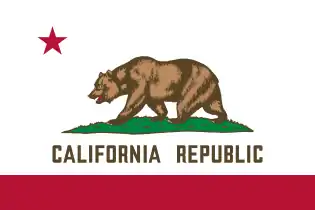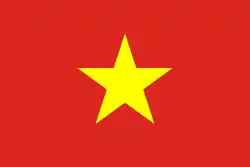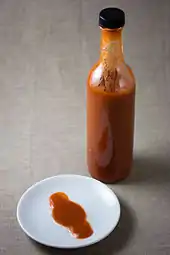Sriracha sauce (Huy Fong Foods)
Huy Fong's Sriracha sauce (/ʃrɪəˈrɑːtʃə/;[2] Vietnamese: Tương Ớt Sriracha), also referred to as Sriracha or Rooster sauce for the rooster on its label, is a brand of Sriracha, a chili sauce that originated in Thailand. The sauce is produced by Huy Fong Foods, a California manufacturer, and was created in 1980[3] by ethnic Chinese immigrant from Vietnam[4] David Tran.[5] Some cookbooks include recipes using it as their main condiment.[6]
| Tương Ớt Sriracha | |
|---|---|
A bottle of Huy Fong Sriracha sauce (with trademarked rooster logo pixelated) | |
| Heat | |
| Scoville scale | 1,000-2,500[1] SHU |
| Sriracha sauce | |||||||||||||
|---|---|---|---|---|---|---|---|---|---|---|---|---|---|
| Chinese name | |||||||||||||
| Traditional Chinese | 是拉差香甜辣椒醬 | ||||||||||||
| Simplified Chinese | 是拉差香甜辣椒酱 | ||||||||||||
| |||||||||||||
| Vietnamese name | |||||||||||||
| Vietnamese | Tương Ớt Sriracha | ||||||||||||
| Vietnamese alphabet | Tương Ớt Sriracha | ||||||||||||
| Literal meaning | Sriracha chili sauce | ||||||||||||
It can be recognized by its bright red color and its packaging: a clear plastic bottle with a green cap, text in Vietnamese, English, Chinese and Spanish, and the rooster logo. David Tran was born in 1945, the Year of the Rooster in the Chinese zodiac.[4][7] The green cap and rooster logo are trademarked, but the U.S. Patent and Trademark Office considers "sriracha" a generic term.[8]
Preparation
The sauce's recipe has not changed significantly since 1983. The bottle lists the ingredients "chili, sugar, salt, garlic, distilled vinegar, potassium sorbate, sodium bisulfite and xanthan gum". Huy Fong Foods' chili sauces are made from fresh red jalapeño chili peppers and contain no added water or artificial colors.[9] Garlic powder is used rather than fresh garlic.[10] The company formerly used serrano chilis but found them difficult to harvest. To keep the sauce hot, the company produces only up to a monthly pre-sold quota in order to use only peppers from known sources.[5] The sauce is certified as kosher by the Rabbinical Council of California.[11]
Production
The production of Sriracha sauce begins with growing the chilis. The chilis were grown on Underwood Ranch until the two companies ended their relationship in 2016.[12] David Tran, owner of Huy Fong Foods, contracted about 690 hectares (1,700 acres) of farmland that spreads from Ventura County to Kern County in California.[13] In order to make sriracha, the chili peppers are planted in March.[14]
Tran uses a particular type of machinery that reduces waste by mixing rocks, twigs, and unwanted/unusable chilis, back into the soil.[14] The chilis are harvested in mid-July through October and are driven from the farm to the Huy Fong Foods processing facility in Irwindale.[13]
Because Tran does not add food coloring to the sauce, each bottle varies in color. At the beginning of the harvest season, the chilis are greener and therefore, the sauce yields a more muted-red color. Later in the season, the sauce produced is bright red.[14] After the chilis are harvested, they are washed, crushed, and mixed with the other ingredients including chili, sugar, salt, garlic, distilled vinegar, potassium sorbate, sodium bisulfite as preservatives, and Xanthan gum.[15] The sauce is loaded into drums and then distributed into bottles. All drums and bottles are manufactured on-site, to reduce waste and emissions.[14]
Nutritional value
[15] Serving size: 1 tsp, Calories: 5, Calories from fat: 0, Total fat: 0g, Sodium: 75 mg, Total carbohydrate: 1g, Sugars: 1g, Protein: 0g, Vitamin A: 0%, Vitamin C: 0%, Calcium: 0 Iron: 0
Scoville scale heat rating
Huy Fong Foods Sriracha sauce ranks in the 1,000–2,500 heat units range, above banana pepper and below Jalapeño pepper, on the Scoville scale used to measure the spicy heat of a chili pepper.[1]
History

David Tran began making chili sauces in 1975 in his native Vietnam, where his brother grew chili peppers on a farm north of Saigon.[4] In 1978, the Vietnamese government began to crack down on ethnic Chinese in south Vietnam. Tran and three thousand other refugees crowded onto the Taiwanese freighter Huey Fong, heading for Hong Kong. After a month-long standoff with the British authorities, its passengers disembarked on January 19, 1979.[16]
Tran was granted asylum in the United States. He started Huy Fong Foods in 1980, naming the company after the refugee ship that brought him out of Vietnam. The sauce was initially supplied to Asian restaurants near his base in Chinatown, Los Angeles,[3] but sales grew steadily by word of mouth.
In December 2009, Bon Appétit magazine named the sauce Ingredient of the Year for 2010.[17][18]
In 2012, over 20 million bottles were sold.[3] Huy Fong Foods says demand has outpaced supply since the company started making the sauce. The company does not advertise because advertising would widen that gap. Huy Fong has boosted production since 2013.[19]
Sriracha sauce has grown from a cult taste to one of the food industry's most popular fads. It infuses burgers, sushi, snacks, candy, beverages and even health products. Tran said he was dissuaded from securing a trademark on the word sriracha since it is difficult to obtain one named after a real-life location. This has allowed others to develop their own versions, using the name. Some of the biggest corporations in the business, such as Heinz, Starbucks, Frito-Lay, Applebee's, P.F. Chang's, Pizza Hut, Subway and Jack in the Box, use the name without licensing it.[8][20] In 2016, Lexus partnered with Huy Fong Foods to build a single promotional Sriracha IS sport sedan.[21]
Lawsuits
In October 2013, the city of Irwindale, California, filed a lawsuit against the Huy Fong Foods factory after approximately 30 residents of the town complained of the spicy smells the factory was emitting while producing Sriracha sauce. The plaintiff initially sought an injunction enjoining Huy Fong from "operating or using" the plant.[22] On November 27, 2013, Judge Robert H. O'Brien ruled partially in favor of the city, declaring Huy Fong Foods must cease any operations that could be causing the noxious odors and make changes to mitigate them, though he did not order that operations cease completely. According to the judge, although there was a "lack of credible evidence" linking locals' complaints of breathing trouble and watering eyes to the factory, the odor that could be "reasonably inferred to be emanating from the facility" is, for residents, "extremely annoying, irritating and offensive to the senses warranting consideration as a public nuisance."[23]
In late January 2014, the city of Irwindale announced it was expanding its case against Huy Fong Foods to include a claim of breach of contract, alleging that the plant violated a condition of its operating permit by emitting harmful odors.[24] The case was scheduled for jury trial in Los Angeles Superior Court on November 3, 2014.[25] On May 29, 2014, it was announced that Irwindale had dropped the lawsuit against Huy Fong Foods.[26] During the legal battles, a Texas delegation offered incentives to move operations to Denton.[27] Other states had also made offers for potential relocation.[28]
There is a long history of lawsuits between Huy Fong & Underwood Ranches, its primary supplier of jalapeños since the 1980s. In 2016, Huy Fong overpaid Underwood by $1.46 million. According to Underwood's lawyer, Tran attempted just before this to hire away Underwood's COO in order to form a new chile-growing concern, breaking the trust between Tran and Underwood. Huy Fong sued Underwood for not paying back this overpayment; Underwood countersued for breach of contract. In July 2019, the case was decided generally in favor of Underwood, with a California jury awarding the grower $10 million in punitive damages and $14.8 million to make up for lost contract revenue between 2016 and 2019. However, the jury also decided that Huy Fong's claim of overpayment was valid, so $1.46 million was deducted from the damages.[29][30]
Documentary film
Filmmaker Griffin Hammond produced a 33-minute documentary about Sriracha sauce.[3] It was funded with the help of a Kickstarter campaign which raised $21,009—over four times the goal. The film was released online[31] on December 11, 2013 in advance of submission to film festivals.[32]
See also
- List of hot sauces
 California portal
California portal Food portal
Food portal Companies portal
Companies portal Vietnam portal
Vietnam portal
References
- "Sriracha: The Incredible Edible Rooster Sauce". catholicfoodie.com. Archived from the original on 1 January 2014. Retrieved 16 October 2017.
- "Comments". Huy Fong Foods. Archived from the original on 31 October 2013. Retrieved 15 July 2013.
- "Sriracha: How a sauce won over the US". News Magazine Monitor. UK: BBC. 20 December 2013. Archived from the original on 2013-12-21. Retrieved 2013-12-22.
- Edge, John T. (May 19, 2009). "A Chili Sauce to Crow About". The New York Times. Archived from the original on October 17, 2016. Retrieved February 25, 2017.
From 1975 onward, Mr. Tran made sauces from peppers grown by his older brother on a farm just beyond Long Binh, a village north of what was then Saigon. ... Though he never devised a formal name for his products, Mr. Tran decorated each cap with a rooster, his astrological sign.
- Shyong, Frank (April 12, 2013). "Sriracha hot sauce purveyor turns up the heat". Los Angeles Times. Archived from the original on 2013-12-16. Retrieved 2013-12-22.
- Clemens, Randy (2011). The Sriracha Cookbook. Berkeley: Ten Speed Press. ISBN 978-1-60774-003-2.
- "Firetalkers: Interview with David Tran of Huy Fong Foods, Inc., Makers of Sriracha "Rooster" Sauce". Archived from the original on 2015-02-14. Retrieved 2015-02-13.
Scott: Why did you choose to put a rooster on your sauce bottles? David: I was born in the Year of the Rooster [1945].
- Pierson, David (10 February 2015). "With no trademark, Sriracha name is showing up everywhere". The Los Angeles Times. Archived from the original on 7 June 2020. Retrieved 16 April 2020.
Two dozen applications to use the word have been filed with the United States Patent and Trademark Office. None has been granted for Sriracha alone. The word is now too generic, the agency determined. ... Unlike the name, Tran trademarked his rooster logo and distinctive bottle.
- Garbes, Angela (2011). The Everything Hot Sauce Book: From growing to picking and preparing — all you need to add some spice to your life!, p.92. ISBN 9781440530654. "A combination of fresh red jalapeños, garlic, sugar, salt, and vinegar."
- Clemens, Randy (2011). The Sriracha Cookbook: 50 "Rooster Sauce" Recipes that Pack a Punch, p.10. Random House. ISBN 9781607740582
- Huy Fong Foods Archived 2013-12-31 at the Wayback Machine at Rabbinical Council of California's website
- Díaz, Alexa (July 12, 2019). "Jalapeño farmer wins $23.3 million in heated dispute with Sriracha maker". Los Angeles Times. Archived from the original on 2019-07-13. Retrieved 2019-07-14.
- "David Tran: How a Vietnamese Refugee Founded a Multi-Million Dollar Sriracha Empire". nextshark.com. Archived from the original on 29 September 2017. Retrieved 16 October 2017.
- "Sriracha: From the Farm to Your Table". farmtotablela.com. 14 October 2014. Archived from the original on 22 October 2017. Retrieved 16 October 2017.
- "Lose weight & improve your health with a real food diet - Fooducate". www.fooducate.com. Archived from the original on 6 August 2016. Retrieved 16 October 2017.
- Girardet, Edward (August 6, 1980). "Powerful magnet for Asian refugees". Christian Science Monitor.
One such ship, the Huey Fong, arrived in Hong Kong on December 23, 1978, claiming to have rescued its refugees off the Vietnamese coast....On January 19, the ship entered Hong Kong Harbor without permission and the refugees disembarked.
- Von Biel, Victoria (16 December 2009). "Best Foods of the Year". Bon Appétit. Archived from the original on 6 October 2011. Retrieved 20 February 2013.
- Patterson, Daniel (January 2010). "Sriracha: 4 Recipes for a $5 Ingredient". Bon Appétit. Archived from the original on 25 April 2013. Retrieved 20 February 2013.
- Ferdman, Roberto A. (10 February 2015). "The sad truth: Sriracha, the world's coolest hot sauce, is losing its edge". The Washington Post. Archived from the original on 12 July 2015. Retrieved 18 September 2015.
- Hannan, Caleb (21 February 2013). "Sriracha Hot Sauce Catches Fire, Yet 'There's Only One Rooster'". businessweek.com. Archived from the original on 6 January 2015. Retrieved 18 September 2015.
- Tim Nudd. "Lexus Just Made a Sriracha Car, and No This Isn't an April Fools' Joke: Auto brand just got spicier". adweek.com. Archived from the original on 18 November 2016. Retrieved 18 November 2016.
- Weinstein, Nicole B.; Krainin, Daniel M.; Schoonmaker, Mackenzie S. (17 February 2014). "Sriracha Hot Sauce Plant Ordered to Cease Spicy Odors". The National Law Review. Archived from the original on 25 February 2014. Retrieved 19 March 2014.
- "Sriracha hot sauce factory ordered to partially shut down". CBC.ca. CBC/Radio-Canada. Associated Press. Archived from the original on 28 November 2013. Retrieved 28 November 2013.
- Shyong, Frank (2014-01-31). "More legal woes for Sriracha plant in fight with Irwindale". latimes.com. Archived from the original on 2014-02-13. Retrieved 2014-02-11.
- "Irwindale's Case Against Sriracha Factory To Go To Trial This Fall". Losangeles.cbslocal.com. 2014-01-31. Archived from the original on 2014-02-02. Retrieved 2014-02-11.
- Shyong, Frank (May 29, 2014). "Sriracha truce brokered with help of Gov. Jerry Brown's office". Los Angeles Times. Archived from the original on January 30, 2020. Retrieved April 16, 2020.
- Shah, Khushbu (1 May 2014). "Is California's Sriracha Factory Considering a Texas Move?". Eater.com. Archived from the original on 11 December 2015. Retrieved 18 September 2015.
- Favot, Sarah (16 April 2014). "Sriracha hot sauce maker considers moving to Texas". Pasadena Star-News. Los Angeles Daily News. Archived from the original on 11 December 2015. Retrieved 18 September 2015.
- "Sriracha And Its Pepper Farmer Are Mad At Each Other". Modern Farmer. 2019-07-23. Archived from the original on 2019-07-23. Retrieved 2019-07-23.
- "Archived copy". Archived from the original on 2019-07-14. Retrieved 2019-07-14.CS1 maint: archived copy as title (link)
- Hammond, Griffin (December 11, 2013). "Watch Sriracha, the movie!". srirachamovie.com. Archived from the original on 2013-12-15. Retrieved 2013-12-22.
- Harris, Jenn (June 13, 2013). "Sriracha documentary: Everything you need to know about the fiery sauce in 30 minutes". Los Angeles Times. Archived from the original on 2013-12-21. Retrieved 2013-12-22.
External links
- Huy Fong Foods, Inc. (official webpage), Huy Fong Foods
- "The highly unusual company behind Sriracha, the world's coolest hot sauce". Quartz. October 21, 2013.
- "How a Vietnamese Refugee Founded a Multi-Million Dollar Sriracha Empire". 6 July 2016. Archived from the original on 2017-09-29. Retrieved 2017-12-04.
- "Sriracha: From the Farm to Your Table". Archived from the original on 2017-11-22. Retrieved 2017-12-04.
- "Huy Fong Foods Sriracha Hot Chili Sauce". Archived from the original on 2016-08-06. Retrieved 2017-12-04.
